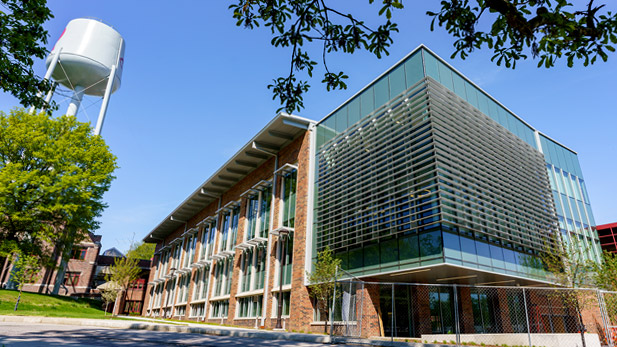New Academic Building Will Open New Design, Classroom & Science Opportunities

A new 70,000-square-foot academic building opening at Rose-Hulman this fall will include state-of-the-art design studios, collaborative workspaces and science laboratories.
A new academic building opening at Rose-Hulman this fall will include state-of-the-art design studios, collaborative workspaces and science laboratories for students who like to innovate, make new products and food, or mix complex chemical compounds for research projects.
Inside the 70,000-square-foot, $29 million building, students will be able to take their creative ideas from conceptual renderings to working prototypes and eventual finished products – all within walking distance of design studios, collaboration workspaces, laser-cutting devices, 3D printers, machine tools, and CNC machines.
The middle floor of the new academic building will have flexible classrooms with embedded video technology that allow students and faculty to easily learn together and share ideas about computer-aided design concepts. This reinforces the fundamental elements of the institute’s science, technology, engineering and mathematics education that’s revered nationally by higher education peers and helps provide a strong return on investment.
On another floor, chemistry and biochemistry students will be able to use the same advanced equipment as professionals as early as their first year. Connected workspaces also allows for more interdisciplinary opportunities for undergraduate research.
“This new facility offers tremendous opportunities for the types of teaching, hands-on learning and undergraduate research that has come to define a Rose-Hulman education,” says Provost and Vice President for Academic Affairs Rick Stamper. “It is exciting to think about the educational experiences that the students will have in this building and how they will use this education to have a positive impact on the world.”
The building also will be the new home base for the expanding engineering design program; provides more space for chemistry and biochemistry instruction and research; and introduces a new food science development and testing laboratory.
Collaboration is a key element of the design studios, flexible classrooms and workspaces. Instead of traditional educational environments with professors lecturing in front of students sitting behind desks, there will be small and large tables with embedded video technology that allows students to easily learn together and share ideas. Video screens placed high on the walls allow for concepts and designs that will enable professors to move around the room.
“The design studios are designed for efficient teamwork and learning,” states Patsy Brackin, director of the engineering design program. “We value learning by doing. Hands-on skills are an important aspect of our program. We sketch, program, produce CAD models and use 3D printers and other forms of technology to communicate our designs to stakeholders and gather feedback. We have found that the best way to get this feedback is from creative prototypes.”
Another interesting aspect of the new building is that it aligns science with engineering. Head of the Department of Chemistry and Biochemistry Ross Weatherman says, “We’ve always emphasized how chemistry and biochemistry connect to every discipline at Rose and that many of the innovations happening in engineering and science are happening at the molecular level. Molecules are our specialty and we provide excellent resources and training to anyone who is interested.”
A design feature of the new academic building will be a central atrium, with interior and exterior glass making it a “window into Rose” that showcases all of the work taking place within the building, along with such science laboratory equipment. This will allow guests to see students working together alongside professors on classroom and specialty research projects.
“The new space design integrates equipment into the teaching space and makes everything much more accessible,” says Weatherman, who adds that the new chemistry laboratories will further enhance the undergraduate research experiences which are a strength of the Rose-Hulman chemistry and biochemistry program.
Specifically, students making a new compound as a possible new anti-breast cancer drug might need an analytical technique to examine elements of the compound and a biochemical technique to examine the compound’s success. These elements of the scientific discovery process can be easily integrated within proximity of laboratories and workspaces inside the new building.
“Every last space in the chemistry and biochemistry area has been designed with the specific intent of facilitating group work,” Weatherman says. “This new building will be transformational event for the department and the institute.”
The new academic building has been supported through a $15 million lead gift from an anonymous donor, along with other individual and family donors, as part of the Mission Driven Campaign for Rose-Hulman.